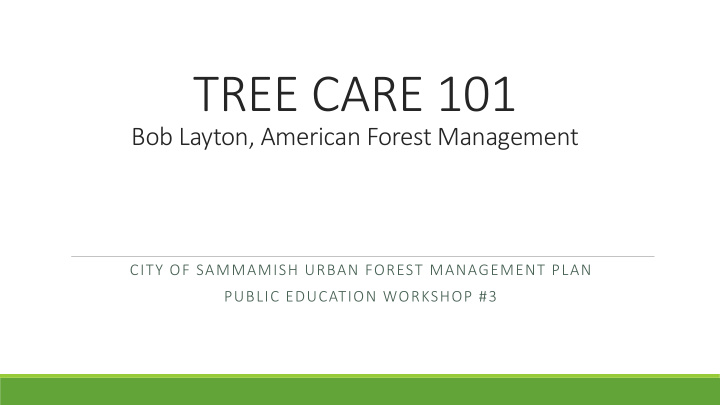



TREE CARE 101 Bob Layton, American Forest Management CITY OF SAMMAMISH URBAN FOREST MANAGEMENT PLAN PUBLIC EDUCATION WORKSHOP #3
TREE CARE 101 Best management practices for home tree care Identifying and managing tree disease How to identify and manage native species Tree selection for different types of sites
Best Management Practices for Home Tree Care
Trees don’t like changes to their environment
Drought Stress
Raising the grade around trees kills roots
So does lowering the grade
Sunscald
Sunscald-Summer and Winter
White Trunk Wrap
Sapsucker Damage
Soil Compaction
Pruning
Structural Pruning
How to correctly make a pruning cut
Here’s the process
What you don’t want to happen
Protect the branch collar and bark ridge
Tree Planting
Tree Staking after Planting
Tree Staking
IDENTIFYING AND MANAGING TREE DISEASE
Powdery Mildew
Brown Rot
Verticillium Wilt
Anthracnose
How to Manage for Fungal Disease - Cultural Cultural Methods Prune out dead or infected branches Rake and destroy fallen leaves from spring to fall Don’t let irrigation wet the canopy (leaves) Choose disease resistant cultivars Chemical Develop a spray program based on the species. This will take several applications at the right times of year
Insects/Pests
Hemlock Woolly Adelgid
Cooley Spruce Gall Adelgid
Douglas fir Sequoia Pitch Moth
Douglas fir Sequoia Pitch Moth
Bronze Birch Borer
BBB
Bark Beetle Galleries
Western Tent Caterpillar
How to Manage for Pests Most of our pest issues are aesthetic and not compromising to tree health or longevity, such as aphids, adelgids, pitch moths and tent caterpillars. Significant infestations of aphids and adelgids can be treated with an insecticidal soap purchased from most lawn and garden stores. Remove tent caterpillar infestations by pruning off the limb the nest is attached to and dispose of properly (submerge in bucket of soapy water or burn) Bark beetles normally are a secondary issue and will attack stressed trees only, the exception being the Bronze Birch Borer
How to Identify and Manage Native Species Douglas fir Western hemlock Western red cedar Big leaf maple Black cottonwood Red alder Scouler’s willow, Cascara, bitter cherry, Sitka spruce, Shore pine, Western white pine, grand fir, Madrone, Oregon ash, P. dogwood, P. crabapple
Douglas fir
DF Bark
DF Cone
Douglas fir Traits
Branch failures Common
Cambium Ruptures
Crooks and Forks
Susceptible to Root Disease
Schweinitzii Root Disease
Laminated Root Rot
Western Hemlock
WH bark and foliage
WH
WH Traits
WH – Root Disease
WH – Frost Cracks
WH - Mistletoe
Wester Red Cedar
WRC
Cedar Traits
WRC
WRC
WRC – Forked Tops
WRC
WRC - Sunscald
Big leaf maple
Big leaf maple
BLM Bark
BLM Traits
BLM – problematic forked stems
BLM – branch failures
BLM Diseases
BLM – Kretzschmaria duesta
BLM – Ganoderma applanatum
BLM Decline
Black Cottonwood
Cottonwood Traits
CW
CW
Red alder
Red Alder Traits
RA – Natural Decline
RA – Nitrogen Fixer
Tree Selection Guidelines
Consider Growth Habit and Size
Consider Rate of Growth
Consider Tree Form or Growth Traits
Consider Future Maintenance
Trees don’t live forever
Questions?
Recommend
More recommend